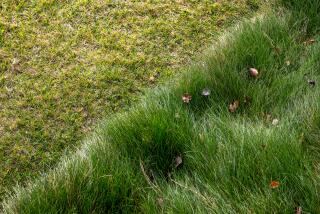WATERCRESS : Buy It by the Bunch : The business Al Beserra’s grandparents began now also grows leeks and mushrooms.
- Share via
Al Beserra’s grandparents, migrating from Mexico during the early 1930s, landed in the San Gabriel Valley and began searching for employment. Those were lean times.
“It was a hard situation for them to get jobs back then,” said the 59-year-old Beserra, a Fillmore resident. Job-seeking proved futile, so his resourceful grandparents turned to the rich land for relief.
“They began to gather plant life that was growing wild in the clean mountain springs around the area,” Beserra said. “They earned money by selling it at the produce market in Los Angeles.”
The elder Beserras were soon doing brisk business in L.A. with a few fresh aquatic herbs.
“They decided to start growing some of the plants themselves,” Beserra said, and soon a tiny enterprise was born.
“My grandparents started the business to take advantage of a market niche,” Beserra said. Of particular interest to their clientele was the delicate-leafed watercress plant. They cornered the local watercress market; business boomed.
“Watercress was the family’s main source of income,” Beserra said. “My father entered the business too, and during the 1950s we packed up and moved to Fillmore and started growing here. It has since become a family tradition.”
Today, Beserra, owner of California Watercress Inc., surmises that the firm “is the largest watercress grower this side of the Rockies.” It’s also one of only a handful.
Southern California is home to about five small growers, Beserra said. And across the country, there are other purveyors of commercially grown watercress, though not many.
“The few of us are able to fulfill the nation’s market, which at times still becomes saturated because there’s only so much demand,” he said.
Utilizing about 65 acres of flood plain in the Santa Clara Valley for his watercress grange, Beserra and family--which includes seven siblings and their respective broods--are looking to expand. (The family also raises a few other edibles, including oysters, mushrooms and leeks.)
“Besides small, growing areas in Watsonville and Mexico, we’re trying to start one back East,” he said, citing West Virginia or Tennessee as possible locales. “We’ll be able to be closer to and meet the needs of our clients back there.”
Much of the family’s watercress is shipped out of state to such destinations as Washington, the Eastern seaboard and Canada. But a fresh batch is available locally too.
“My granddaughter, Chris Chuning, attends the Ojai and Ventura farmers’ markets and offers some of our stuff there,” Beserra said.
“The taste of watercress is a little bitter, a little pepperish,” he said. “Not all people like it. We’ve brought new strains over from Europe--we call it broad leaf watercress--which has a better taste and is better quality.”
Today, watercress--reportedly first cultivated in England in 1808--is a popular addition to salads, soups and stir fry.
“In the ‘60s, the demand was small, but today more people have discovered it and demand is way up,” Beserra said. He attributes the rise in popularity here in the United States to the “health foodies,” who added watercress to their diets, not only for flavor embellishment but for its nutritional value.
In fact, the green, thinly stemmed herb was once commonly grown for its nutritive properties. “We used to sell watercress to some of the vitamin companies,” he said, “but they have since found other products to take its place.”
Some of Beserra’s watercress still goes into making Campbell’s V-8 brand vegetable juice and canned soups. His mother used the plant as a thirst-quenching drink.
“She would pound and grind the watercress for its juice, dilute it with cool water and add honey,” he said. “That proved to be a very healthful drink.”
You’re most likely to find fresh watercress in upscale markets, including Mrs. Gooch’s in Thousand Oaks.
“We carry it year-round and at different times we’ll have organically grown watercress,” said Cliff Kersey of Mrs. Gooch’s. “It’s basically used like an all-purpose lettuce leaf for salads and sandwiches. And people will use it in Oriental dishes like chop suey.” Kersey said the texture of watercress can be likened to butter lettuce.
When shopping for watercress, look for bright-green, full leaves that show no signs of yellowing or wilting. Try to select those with small, tender stems rather than large, tough ones.
Sold in bunches at Mrs. Gooch’s, organic watercress sells for around $1.59, while the regular goes for about 98 cents.
SERVING SUGGESTION: WATERCRESS SOUP
1 clove garlic
2 tablespoons butter
White pepper
Salt
4 small leeks
4 cups clear chicken broth
1/2 pint whipping cream
1 bunch watercress
Cut leeks in half almost to root end. Clean well under running water. Cut off root end and green portion. Thinly slice white portion of leeks. Mince one clove garlic.
Heat 2 tablespoons butter in saucepan until melted.
Add leeks and garlic to saucepan and saute until tender, about 5 minutes. Add 4 cups chicken broth. Bring to boil. Reduce heat, cover and simmer 10 minutes.
Puree in blender, then return to saucepan. Stir in 1 cup whipping cream. Heat to boiling. Reduce heat and simmer about 10 minutes or until slightly thickened.
Remove leaves from 1 bunch watercress. Chop leaves and add to cream soup. Bring to simmer. Cook 4 to 5 minutes. Season to taste with white pepper and salt.
Makes 4 servings.
More to Read
Inside the business of entertainment
The Wide Shot brings you news, analysis and insights on everything from streaming wars to production — and what it all means for the future.
You may occasionally receive promotional content from the Los Angeles Times.










